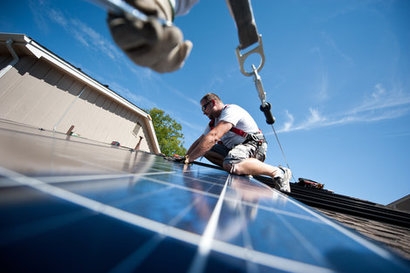
The report explains that governments, utilities and renewables firms are realising that not only is solar PV already the cheapest way to generate electricity, and will get increasingly cheaper, but also that the emergence of battery energy storage makes solar a more predictable resource.
Disruption in energy markets caused by the slowing natural gas markets, means that there will be a massive demand by consumers to put solar on their rooftops anywhere that makes commercial sense. A massive expansion is likely to take place as government pressure to make policy changes sees consumers rewarded for rooftop self-supply, smoothed by battery energy storage. Rooftop solar at its peak will represent 59 percent of annual additions to capacity by 2050.
The report introduces the concept of ‘rooftop capacity per capita’ and forecasts that countries such as Poland, Italy, China, the US and Vietnam and even the Netherlands, will begin to chase the leader, Australia, in GW of rooftop solar installed per million inhabitants.
Solar will also be at the centre of the ‘green hydrogen’ sector which will build momentum through to 2030 and then absorb a staggering amount of cheap electricity into the electrolysis process, mostly from cheap solar megaprojects in Australia, North Africa, the Middle East, and throughout China and the Americas, including irradiation hotspots like Chile.
The scale of the growth in annual additions will be staggering, progressing a huge 14.35 percent each year (Compound Annual Growth Rate) through to 2030, before falling back to the more prosaic 9.7 percent CAGR through to 2040.
However, there will be considerable problems along the way finding and funding sufficient polysilicon, and even more problems wresting dominance of the industry away from China. New forms of solar will also emerge, as PERC gives way to TOPCON, gives way to heterojunction and tandem designs and finally perovskite comes of age.
Rethink Energy claims that all of that will happen in the next 30 years, but also that new superpowers in solar irradiation will erupt onto the scene, and places like Chile and Australia will built giant energy export businesses based on the power of both solar and wind.
Global annual solar additions will hit 617 GW in 2030, and peak at 1022 GW in 2040, before sliding back to a mostly replacement business in the run up to 2050.
The report also introduces a formula for calculating when solar Repowering will happen, so gives real insight into the relationship between module manufacture and annual additions.
“As we write this report, we understand that solar is actually rising in price day today” said Rethink Energy analyst Andries Wantenaar and lead author of Global Solar Forecast 2050: Country breakdowns of 22.9 TW of solar by 2050, but this is only due to the cramped supply of polysilicon, and this crisis will remain part of the pricing equation for some time to come, at least 4 or 5 years, until polysilicon settles to being simply part of the supply chain once again.”
The report describes this process in detail, one country at a time, taking in the top 33 regions for solar output, whether that is now or at any stage during the next 30 years.
Most forecasters change their forecasts each quarter, but Rethink Energy believes that the future of solar over the 30 years period is unlikely to change decade to decade, although the company accepts that pricing crises will dictate what it does year to year.
For additional information:
Global Solar Forecast 2050 (Executive Summary)

